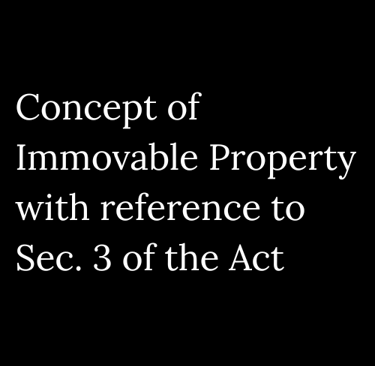Ineterpretation Clause -- Immovable Property Explained
Immovable Property - Definition; Why is it important to Distinguish between Movable and Immovable Property
5/29/20255 min read
Interpretation Clause: Section 3 – Transfer of Property Act, 1882. ---
The interpretation clause under section 3 in the transfer of property act provides definitions of the most important terms that are used in the act. It states that unless there is something repugnant in the subject or context, the terms defined under this section shall carry the meaning and definition that was given in this section and they shall be construed and understood accordingly. Thus, the interpretation clause provides definitions to important terms and expressions that might lead to uncertainty and confusion in the absence of this meaning mandating that the expression shall only be understood in the way it is meant for. The following expressions are defined under section 3 of the act.
Immovable Property. –
The definition of immovable property can be given as, “a property that cannot be transported from one place to another without losing its original shape, quality or quantity”. Though defined under section 3, it does not give complete and concrete definition of the term “Immovable Property”. But why is it important to define immovable property? Why is it important to differentiate between the ‘movable property’ and ‘immovable property’. The reason is that there is a separate law governing transfers of movable property and immovable property. The transfer of movable property is governed by the Sale of Goods Act, 1932, whereas the transfer of immovable property is governed by the Transfer of Property Act, 1882. Where the transfer of movable property is levied with sales tax, goods and services tax, the transfer of immovable property is subject to no such tax but is liable to be paid stamp duty under the Indian Stamp Act, 1899 and registered under the Indian Registration Act, 1908 by paying prescribed registration fee. In this context if there is no clear distinction between both the terms it leads to inconsistency. The term immovable property is defined under sec 3 of the immovable property as follows:
“Immovable property. --- “Immovable Property” does not include standing timber, growing crops or grass;” But the definition given under section 3 is only exhaustive and did not give comprehensive picture of the term immovable property. it only excludes standing timber and growing crops from the purview of the immovable property. but the act failed to give a proper definition of the what actually is transfer of property.
The General Cluses Act, 1897 Section 3 (26) also defines immovable property as – “Immovable property shall include land, benefits to arise out of land, and things attached to the earth, or permanently fastened to anything attached to the earth”
The definition given under the general clauses act is inclusive, dividing the concept of immovable property into 4 major kinds viz., land; benefits arisen out of land; things attached to the earth; permanently fastened to anything attached to the earth. Here there is another expression mentioned in the definition - “things attached to the earth”, again defined under the section 3 of the Transfer of property act, as
“attached to the earth” means—
(a) rooted in the earth, as in the case of trees and shrubs;
(b) imbedded in the earth, as in the case of walls or buildings; or
(c) attached to what is so imbedded for the permanent beneficial enjoyment of that to which it is attached;
now we can discuss in detail about the various aspects of the immovable property by understanding each definition..
“does not include standing timber; growing crops or grass”.. --- the definition under section 3 of the transfer of property clearly excludes standing timber and growing corps which are not permanent fixtures to the land. While the immovable property includes things “rooted in the earth as in case of trees and shrubs”, ((a) to the definition of attached to the earth), the courts have ruled out that intent of the transfer has to be taken into consideration. That means standing timber intended to be cut and separated from the ground for the purpose of transportation and sale does not come under the purview of the immovable property and is liable to be paid sales tax. It was clearly explained by the House of Lords in..
Marshall vs. Green (1875) 1 CPD 35 (A); the House of Lords held that a sale of growing timber to be taken away as soon as possible by the purchaser was not a contract for sale of land, or any interest therein, as the purchaser will not draw any benefit from the land.
The Supreme Court held that standing trees intended to be cut and removed were not immovable property in Shantabai v. State of Bombay, AIR 1958 SC 532.
Thakoor Chunder v. Ramdone Bhuttacharjee (1871), the Privy Council held that growing crops are not immovable property even though they are physically attached to the earth.
Houses, Doors, Windows and other permanent fixtures. – the permanent fixtures like houses, doors, windows are fixed to the land for the permanent beneficial use of the purchaser and they can be treated as immovable property. Likewise machinery in a factory so long as they are embedded and routed to the land or the building for the purpose of long term use are considered as immovable property and once they are separated or sold with and intention to be separated they shall be considered as movable property.
If the intention is that it should grow and yield fruits or shade, it is immovable property because it has to draw nourishment from the land. In Seeni Chettiar vs. Santhanathan (Mad. 58 PC), there was an agreement between the parties for right to cut and enjoy trees for a period of 4 years, and during the said period the transferee had to nourish the trees for further growth for four years. The Privy Council held that the agreement and the intention between the parties was to derive benefit of nourishment from the land for a period of 4 years and not to immediately cut down. Hence it comes under the purview of immovable property and liable to be registered under the Indian Registration Act, 1908.
In Ananda Behara v. State of Orissa (1956 SCJ 96) the Supreme Court held that sale of “right to catch fish from a lake or pond” in an aqua farm is immovable property and requires a valid registered document as the fish is grown in the lake or pond and it is arising out of the benefits out of land or immovable property.
Conclusion:
Thus, in order to determine whether a property or a right or interest in property comes under the definition of the immovable property or not, a reliance has to be placed on the intent of the parties at the time of transfer. There is no confusion regarding the definition in case of agriculture lands, houses, permanent fixtures. But when it comes to the things that can be cut down or separated form the earth or from anything fastened or rooted in the earth the intention with which the transfer was made plays a major importance. If there is a particular period where the things has to be nurtured or nourished or in any case derive benefits out of the land or permanent fixtures, such properties shall be deemed as immovable properties.
The other definitions in interpretation clause under section 3 of the transfer of property act will be clearly dealt in the later posts.


Connect With Us Through
Connect with us
© 2025. All rights reserved.
